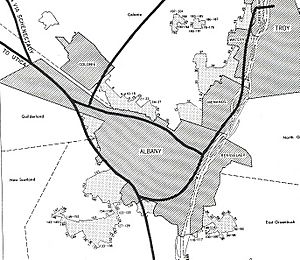History of Albany, New York (1942–1983) facts for kids
The history of Albany, New York from 1942 to 1983 covers the time when Erastus Corning 2nd was the city's mayor. His time as mayor started in 1942 and ended when he passed away in 1983.
Contents
A Long-Serving Mayor
Erastus Corning 2nd was a very important mayor for Albany. He was elected in 1941 and served until his death in 1983. This made him the longest-serving mayor in the history of any city in the United States!
Some people say that even though he was mayor for a very long time, he didn't make many big changes. He preferred to keep things as they were. This approach brought stability to Albany. However, it also meant that the city didn't grow or change much during his time. One good thing he did, even if by accident, was help save many of Albany's old and beautiful buildings.

Changes and Challenges
During the 1950s and 1960s, the U.S. government offered money to cities for urban renewal projects. But Albany didn't see much new building or business growth. The city's population dropped by more than 20 percent while Corning was mayor. Many downtown businesses also moved out to the suburbs.
These problems happened in many cities, but they were bigger in Albany. Some people believe this was because of the strong local Democratic political group, which made it hard for new projects to move forward.
Building the Empire State Plaza
Nelson Rockefeller was the Governor of New York from 1959 to 1973. He loved big, grand buildings and large government projects. He was the main person behind building the Empire State Plaza. He also helped build the SUNY Albany campus and the W. Averell Harriman State Office Building Campus.
A local politician once joked that Governor Rockefeller was "the best mayor Albany ever had." This was because Rockefeller pushed for so many big changes. Mayor Corning didn't want the Empire State Plaza built at first. But he ended up working out the payment plan for it.
Governor Rockefeller didn't want to be limited by the state's money rules. So, Mayor Corning came up with a clever plan. The county would pay for the construction, and the state would rent the buildings. The state would then pay off the construction loans until 2004. This was the only way Rockefeller could get his big project done, so he agreed.
Because of this deal, Mayor Corning gained a lot of power. He was able to get the State Museum, a convention center, and a restaurant added back into the plans. Governor Rockefeller had originally said no to these ideas. The county earned $35 million in fees, and the city received $13 million for the taxes it lost.
Interstate 787 and City Planning
Another big project in the 1960s and 1970s was building Interstate 787 and the South Mall Arterial. Construction started in the early 1960s. One major result of this highway was that it cut the city off from the Hudson River.
Some people think Mayor Corning didn't think enough about the waterfront. They believe he could have used his influence to change where I-787 was built. The highway now separates Albany from the river, which was a big part of why the city was founded.
Many parts of the original plan for these roads were never finished. For example, Governor Rockefeller wanted the South Mall Arterial to go through the Empire State Plaza. This would have needed a complex underground road system near Washington Park. Even today, you can still see signs of these unfinished plans.
In 1967, a small area called Karlsfeld became the last piece of land to be added to Albany's city limits. It had previously been part of Bethlehem.

